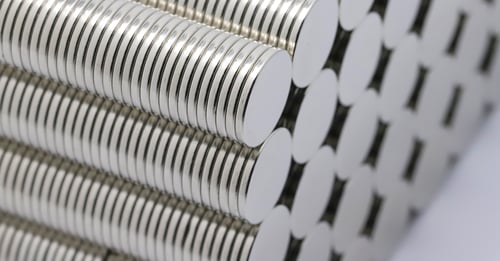A Comprehensive Guide to Grinding Rare Earth Magnets
Rare earth magnets, renowned for their extraordinary magnetic properties, are indispensable in countless modern applications, from cutting-edge electronics to aerospace marvels. The diverse range of rare earth magnets, including neodymium (NdFeB), samarium cobalt (SmCo), and more, each possess distinct characteristics and advantages. In this comprehensive guide, we will delve into the world of grinding rare earth magnets, exploring the six different types, their pros and cons, variations, and why Cubic Boron Nitride wheels stand as the preferred choice for this intricate task. Furthermore, we'll share valuable tips to ensure success in the grinding process.

Types of Rare Earth Magnets
Rare earth magnets encompass a spectrum of materials, each with its unique composition and magnetic properties. Let's delve into the six major types:
Neodymium Iron Boron Magnets (NdFeB magnets):
Pros:
- Exceptional magnetic strength
- Wide range of applications, including electric motors and headphones
- Cost-effective
Cons:
- Susceptible to corrosion
- Low-temperature resistance
Variations: Different grades with varying properties
CBN Usage: CBN wheels excel in precise grinding to maintain dimensional accuracy and surface finish.
Tips: To prevent demagnetization of neodymium magnets, avoid overheating during the grinding process.
Samarium Cobalt Magnets (SmCo magnets):
Pros:
- High-temperature stability
- Resistance to demagnetization
- Long lifespan
Cons:
- Expensive
- Lower magnetic strength compared to NdFeB
Variations: SmCo-5 and Sm2Co17 with different temperature characteristics
CBN Usage: CBN wheels are essential for maintaining magnetic performance during grinding.
Tips: The use of coolant helps manage heat generation during grinding.
Alnico Magnets:
Pros:
- Excellent corrosion resistance
- High-temperature performance
Cons:
- Lower magnetic strength compared to NdFeB and SmCo
Variations: Different compositions with varying properties
CBN Usage: CBN wheels are effective for precision grinding due to their exceptional hardness.
Tips: Proper fixturing is essential to prevent chipping during grinding.
Ceramic Magnets (Ferrite Magnets):
Pros:
- Cost-effective
- Good resistance to demagnetization
Cons:
- Lower magnetic strength compared to rare earth magnets
Variations: Soft and hard ferrite magnets with different properties
CBN Usage: CBN wheels aid in achieving the desired surface finish during grinding.
Tips: Use light pressure during grinding to prevent damage to the magnets.
Samarium Iron Nitride Magnets (Sm2Fe17N3 magnets):
Pros:
- Promising magnetic properties
- Potential for high-efficiency applications
Cons:
- Limited commercial availability
- Ongoing research and development
Variations: Developing, with evolving properties
CBN Usage: As this magnet type matures, CBN wheels may become a suitable option for precision grinding.
Tips: Stay updated on advancements in this emerging magnet type for potential future applications.
Dysprosium (Dy)-Free Magnets:
Pros:
- Reduced reliance on costly dysprosium
- Potential for cost savings
Cons:
- Development in progress
- Varying magnetic properties
Variations: Evolving as research continues
CBN Usage: CBN grinding wheels can be explored as an option as Dy-free magnets develop.
Tips: Stay informed about ongoing research and industry developments regarding Dy-free magnets.
Understanding the diverse landscape of rare earth magnets is paramount for manufacturers seeking to meet specific industry requirements. By examining the pros and cons of each type, businesses can make informed decisions regarding the selection of the right magnet for their unique applications.
CBN Wheels: The Optimal Choice for Precision Grinding
Across all types of rare earth magnets, one common thread emerges – the preference for CBN wheels over diamond grinding wheels in precision grinding. Cubic Boron Nitride (CBN) is a superhard material known for its exceptional abrasion resistance, making it ideal for grinding tasks that demand precision, such as grinding rare earth magnets.
CBN wheels offer several advantages:
- Hardness: CBN is second only to diamond in hardness, ensuring minimal wear during grinding operations.
- Thermal Conductivity: CBN's excellent thermal conductivity helps dissipate heat generated during grinding, reducing the risk of demagnetization.
- Consistency: CBN wheels maintain their shape and cutting ability over extended periods, ensuring consistent results and tolerances
- Versatility: CBN wheels can be tailored to different magnet materials and applications, providing flexibility in the manufacturing process.
Unique Tips for Grinding Rare Earth Magnets
Grinding rare earth magnets demands precision and careful attention to detail. Here are some unique tips to ensure success in this challenging task:
- Fixturing: Proper fixturing on the grinder is essential to prevent chipping and ensure the workpiece remains secure during grinding.
- Coolant Use: Implementing a coolant system helps manage heat generation, especially when grinding SmCo magnets that are sensitive to temperature changes.
- Light Pressure: When grinding ceramic magnets, apply light pressure to minimize the risk of damage to the magnets.
- Stay Informed: Keep a watchful eye on emerging magnet technologies like Dy-free magnets and Sm2Fe17N3 magnets. These developments may offer new opportunities for innovation.
![]()
Grinding rare earth magnets is an intricate process that demands precision, specialized tools, and a deep understanding of magnetic properties. The six different types of rare earth magnets – NdFeB, SmCo, Alnico, Ceramic, Sm2Fe17N3, and Dy-free magnets – each offer unique advantages and challenges. To achieve success in magnet manufacturing, it is essential to select the right magnet type based on specific application requirements.
CBN wheels, with their exceptional hardness and wear resistance, are the preferred choice for precision grinding across all rare earth magnet types. These wheels help maintain magnetic performance, dimensional accuracy, and surface finish during the grinding process.
By incorporating the tips provided and staying informed about emerging magnet technologies, manufacturers can produce high-quality rare earth magnets that meet stringent industry requirements. These magnets continue to drive innovation and power the technologies that shape our world today and tomorrow.
Recent Posts
Subscribe to email updates
Subscribe to our blog to get the latest updates from the experts on Grinding Wheels! You can easily unsubscribe at any time




